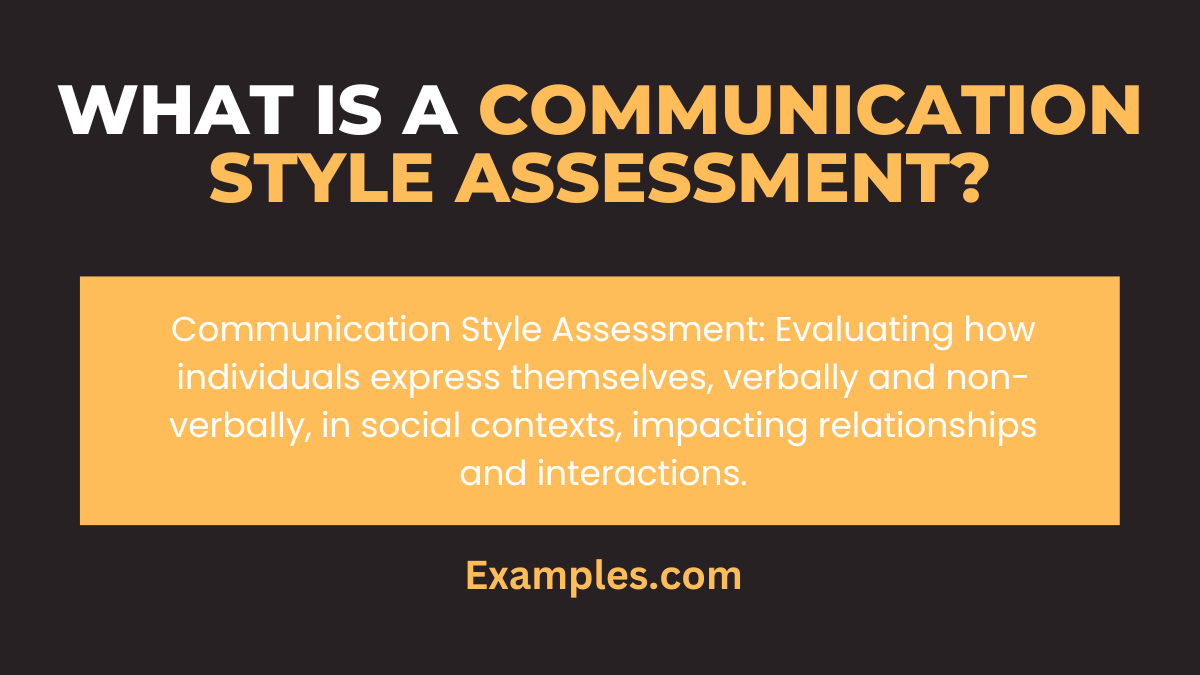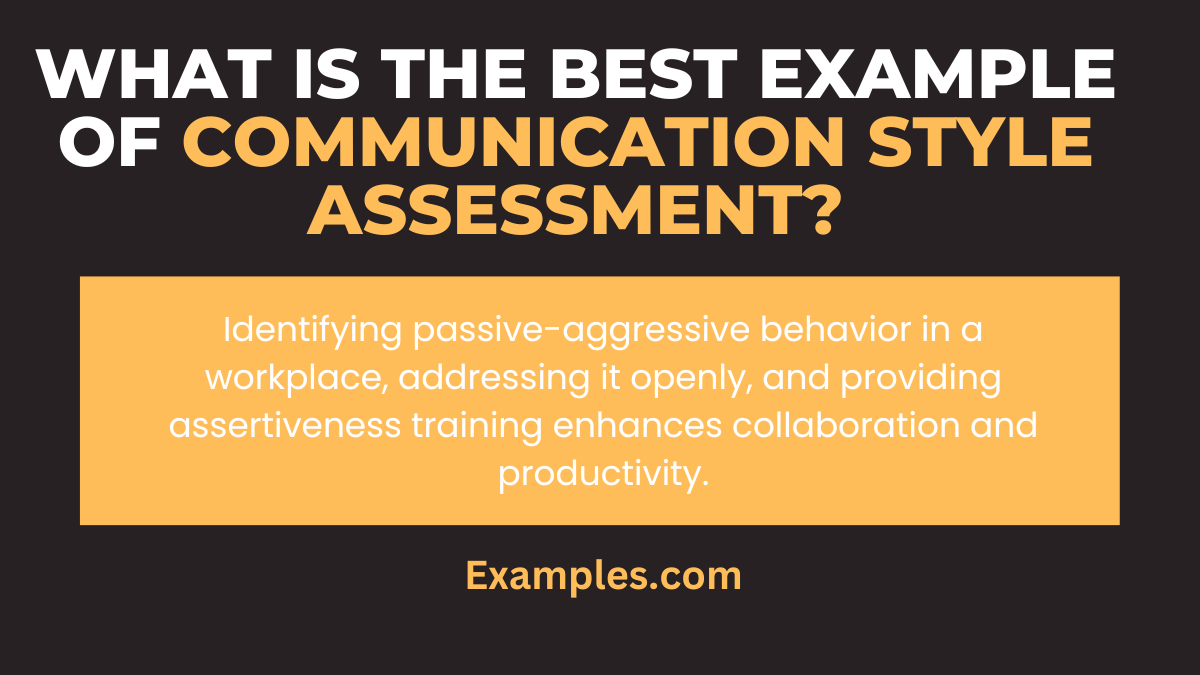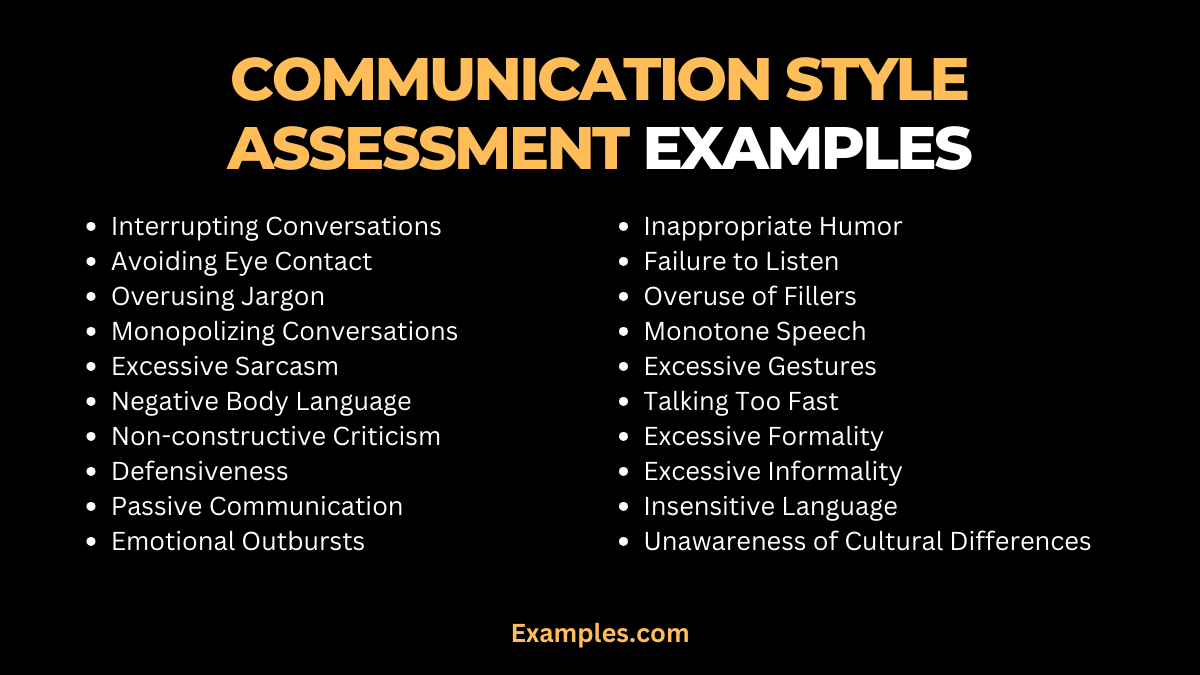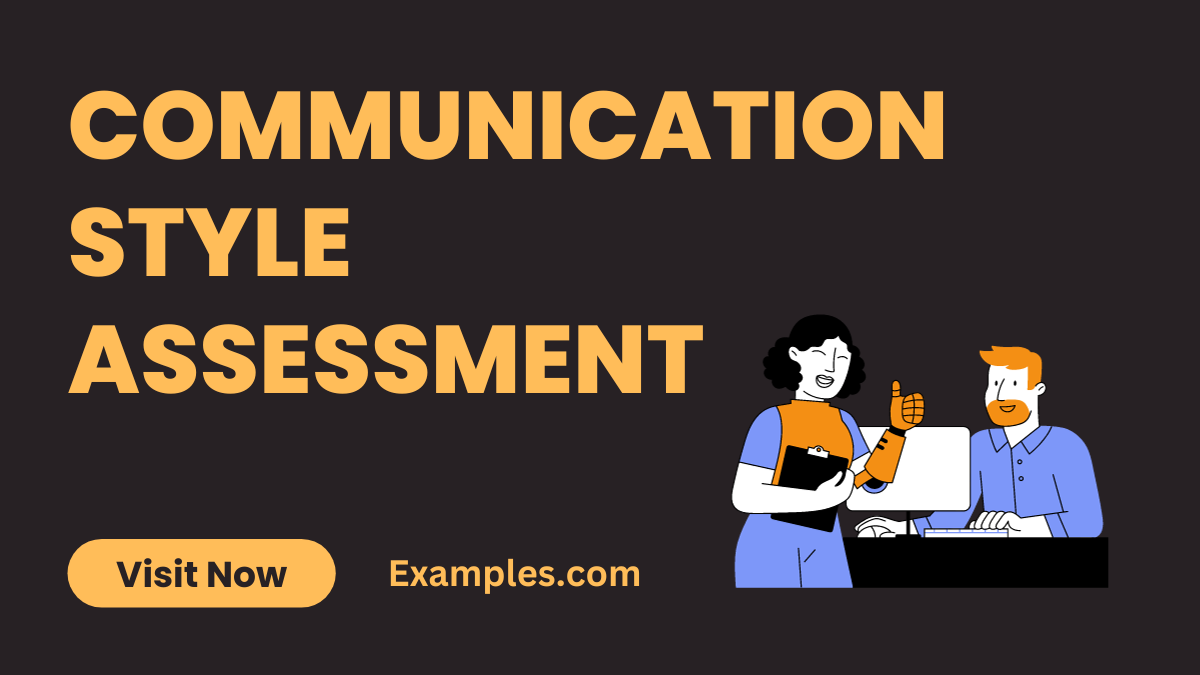19+ Communication Style Assessment Examples
In the realm of effective communication, understanding your communication style is paramount. This guide delves deep into the world of Communication Style Assessment, providing insights, Communication Examples, and actionable strategies to enhance your interpersonal interactions. Discover how recognizing your unique style can lead to more meaningful connections and fruitful conversations.
What is a Communication Style Assessment? – Meaning

Communication Style Assessment is the process of evaluating how individuals express themselves, both verbally and non-verbally, in various social contexts. In simple terms, it’s about identifying how you communicate and how that impacts your Communication Style in Relationships and interactions with others.
What is the best Example of Communication Style Assessment?

A prime example of Communication Style Assessment involves recognizing someone’s passive-aggressive communication style. In a workplace scenario, an employee consistently agrees with their manager’s instructions but fails to meet deadlines or sabotages projects behind the scenes. This passive-aggressive behavior undermines team productivity. By identifying this communication style, addressing the issue openly, and providing assertiveness training, the team can foster a more transparent and effective communication environment, ultimately enhancing collaboration and achieving better results.
20 Communication Style Assessment Examples

Unlock the key to effective communication with these 20 diverse Communication Style Assessment examples. From assertiveness to passive-aggressiveness, each example comes with a clear explanation of what causes it and actionable tips on how to fix and improve your communication style. Whether it’s mastering active listening or refining your body language, these real-world scenarios provide practical insights for smoother, more productive interactions in any setting.
- Interrupting Conversations: Understand why it happens and learn techniques to be a better listener.
- Avoiding Eye Contact: Discover the root causes and how to establish genuine connection through eye contact.
- Overusing Jargon: Learn to simplify your language for clearer communication.
- Monopolizing Conversations: Understand the reasons behind it and how to encourage balanced dialogues.
- Excessive Sarcasm: Explore the impact of sarcasm and ways to use it appropriately.
- Negative Body Language: Identify cues and rectify non-verbal communication to convey positivity.
- Non-constructive Criticism: Find out what drives it and how to provide constructive feedback.
- Defensiveness: Learn to overcome defensiveness for more open and receptive discussions.
- Passive Communication: Understand the drawbacks and embrace assertive communication.
- Emotional Outbursts: Examine the triggers and manage emotions in challenging conversations.
- Inappropriate Humor: Explore the fine line between humor and offense in communication.
- Failure to Listen: Discover the importance of active listening and techniques to improve it.
- Overuse of Fillers: Eliminate unnecessary fillers like “um” and “uh” for clearer speech.
- Monotone Speech: Learn how varying your tone can engage your audience better.
- Excessive Gestures: Understand the impact of exaggerated gestures and practice moderation.
- Talking Too Fast: Find out why pacing matters and how to control your speech rate.
- Excessive Formality: Strike a balance between formality and approachability in communication.
- Excessive Informality: Learn when informality can hinder professionalism and adjust accordingly.
- Insensitive Language: Discover the effects of insensitivity and practice empathy in speech.
- Unawareness of Cultural Differences: Understand how cultural nuances affect communication and adapt for inclusivity.
Communication Style Assessment at Workplace
Workplace Communication Style assessment is crucial for fostering a collaborative and efficient environment. It involves evaluating and understanding the diverse ways team members express themselves and interact. This assessment helps in recognizing and respecting different communication styles, leading to improved teamwork, conflict resolution, and overall productivity. Incorporating a variety of Communication Styles in the Workplace can greatly enhance team dynamics and productivity. Identifying What is the Most Desirable Style Of Communication? varies from one workplace environment to another, but the key is flexibility and adaptability to different needs and situations. Assessing and understanding these styles pave the way for more effective and harmonious interactions among colleagues. Incorporating Communication Styles Examples and considering Communication Styles in Leadership are key to this process.
- Assertive Leader Model: Emphasizes clarity and directness while respecting others’ opinions. Communicate: “I believe this strategy will work best for us; let’s discuss its potential outcomes.”
- The Collaborative Team Member: Focuses on building consensus and encouraging group input. Communicate: “I value everyone’s input; let’s collaborate to find the best solution.”
- The Empathetic Listener: Prioritizes understanding and addressing emotional needs. Communicate: “I understand this is challenging; how can I support you?”
- The Directive Communicator: Uses clear and concise commands, effective in urgent situations. Communicate: “Please complete this task by the end of the day today.”
- The Inspirational Motivator: Uses positive language and enthusiasm to inspire team members. Communicate: “I’m confident in our team’s ability; let’s tackle this challenge together!”
Download Communication Style Assessment Activity PDF
Assertive Communication Style Assessment
An Assertive Communication Style Assessment evaluates how effectively individuals express their needs, rights, and opinions confidently and respectfully. This focuses on identifying and enhancing one’s ability to communicate assertively without being Passive or Aggressive Communication Style . By incorporating aspects from various Types Of Communication Styles, it aims to promote a balanced and direct way of interaction that respects both the speaker’s and the listener’s rights. This assessment is crucial for personal development and fostering healthy relationships in both personal and professional settings. Here are five examples of how to employ an Assertive Communication Style effectively:
- Declining Additional Work Respectfully: “I understand the importance of this project, but I cannot take additional Communication Style for Work at the moment without compromising the quality of my current assignments.”
- Expressing a Contrary Opinion: “While I see the benefits of your approach, I believe a different strategy might yield better results in the long run.”
- Setting Boundaries: “I value our working relationship, but I need to stick to office hours for work-related discussions unless it’s an emergency.”
- Asking for a Raise: “I’ve contributed to the team’s success with measurable results and believe a salary adjustment is now appropriate.”
- Handling Criticism Constructively: “I appreciate your feedback and will take these points into consideration to improve my performance.”
Analytical Communication Style Assessment
The Analytical Communication Style Assessment focuses on understanding how individuals use logic, data, and facts in their communication approach. Incorporating elements from Reflective Communication Style and Casual Communication Style, among others, this assessment aids in honing a person’s ability to communicate complex information efficiently and effectively, making it an invaluable tool in decision-making and leadership roles. Here are five examples of employing an Passive Communication Style:
- Presenting a Report Findings: “According to the data, our sales have increased by 15% this quarter, which indicates a successful implementation of the new marketing strategy.”
- Explaining a Complex Process: “To ensure quality, the production goes through five stages, each with specific quality checks and balances.”
- Making a Recommendation Based on Data: “After reviewing the past year’s expenditure, I suggest reallocating our budget to areas with higher ROI.”
- Dissecting a Problem: “The root cause of the delay seems to be at the supplier’s end. Let’s analyze their delivery patterns for a solution.”
- Critiquing a Plan with Facts: “While the proposed plan is innovative, past data from similar projects suggest a high risk of implementation failure.”
Communication Style Assessment Tools
Communication style assessment tools are vital resources for improving interpersonal skills and understanding. Tools like the DISC assessment available through DISC Personality Testing provide valuable insights into Communication Skill at Workplace. For a approach Program on Negotiation offer in-depth analysis and tips for effective communication strategies, ensuring individuals and teams can communicate more effectively and efficiently.
What is the Purpose of the Communication Style Assessment?
The Communication Style Assessment is designed to identify and understand an individual’s preferred method of communicating, facilitating personal growth and more effective interpersonal interactions. By recognizing one’s unique style, individuals can adapt and enhance their communication in various contexts, from personal relationships to professional environments.
The purpose of assessing communication style is multifold:
- To Enhance Self-Awareness: It helps individuals understand their natural communication preferences, strengths, and areas that need improvement.
- To Foster Better Interpersonal Relationships: By understanding various styles, including Communication Style for Relationships, individuals can tailor their approach to different audiences for more harmonious interactions.
- To Improve Team Dynamics: Especially important for Communication Style for Project Managers, knowing one’s style and the styles of team members can lead to more effective collaboration and project success.
- To Prepare for Professional Settings: Understanding and adapting communication styles is crucial for scenarios like Communication Style for Interview, influencing how one is perceived and can articulate their thoughts and responses.
- To Enhance Leadership and Coaching Skills: For those in roles of influence, such as managers or coaches, understanding communication styles, including their own, allows for more effective guidance and mentorship.
What are the Benefits of Communication Style Assessment?
A Communication Style Assessment offers a range of benefits that can lead to personal and professional development, enhancing the way individuals interact and exchange ideas in various settings.
The benefits of conducting a communication style assessment include:
- Improved Conflict Resolution: By understanding and respecting diverse communication styles, individuals can navigate and resolve conflicts more effectively, essential in both work and personal settings.
- Enhanced Leadership Abilities: Leaders, including those in Communication Style for Coaching roles, can better motivate and connect with their team by adapting their communication approach to suit different members’ styles.
- Increased Team Productivity: With a clear understanding of each member’s communication style, teams can work more cohesively, leading to increased efficiency and productivity, particularly vital for project managers.
- Better Interview Outcomes: Candidates who are aware of their Manipulative Communication Style can better present themselves and respond to questions in interviews, making a more favorable impression.
- Stronger Personal Relationships: Recognizing and adapting to different communication styles can lead to deeper understanding and stronger connections in personal and professional relationships.
How do you Determine Communication Style?
To determine communication style, observe interaction patterns, use communication style worksheets for self-assessment, and seek feedback from peers to identify predominant ways of communicating.
What are the Four Areas of Communication Assessment?
The four areas of communication assessment are verbal expression, non-verbal behavior, listening skills, and adaptability in various contexts, essential for effective communication style with management.
Why is Assessment Important in Communication Style?
Assessment is vital in communication style as it promotes self-awareness, enhances interpersonal relations, and provides strategies on how to improve communication style for personal and professional growth.
In conclusion, understanding and assessing communication styles is crucial for enhancing personal and professional interactions. By recognizing individual patterns, embracing diversity in communication, and adapting to various contexts, individuals can foster more effective dialogue, resolve conflicts, and build stronger relationships. Communication style assessment is a valuable tool for anyone looking to improve their interaction skills and navigate the complexities of interpersonal exchanges effectively.



